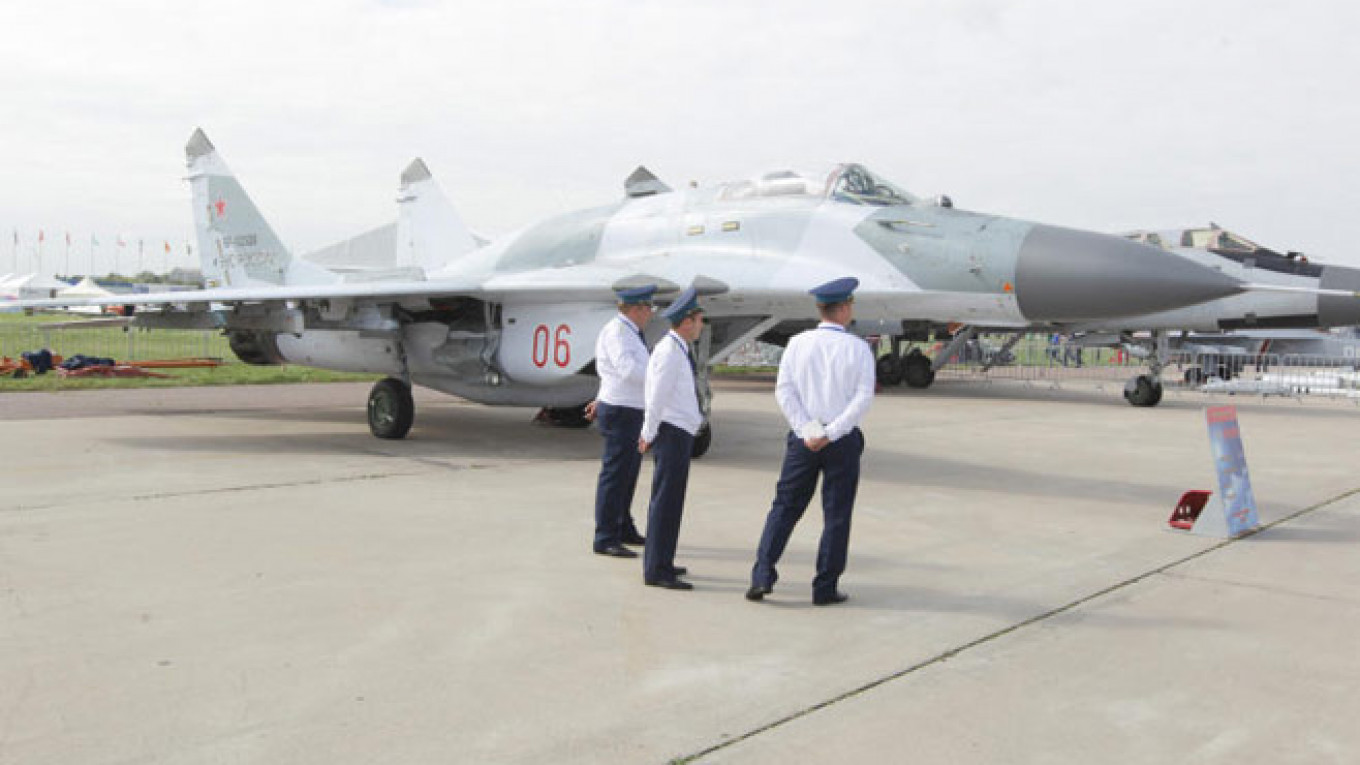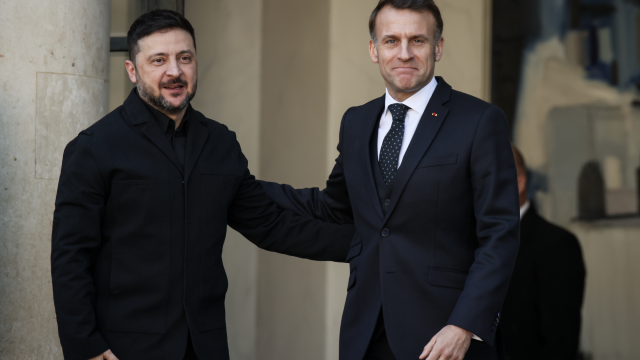Once one of the world's most famous aircraft designers, Russia's MiG aircraft company has fallen on hard times. Though MiG aircraft continue to populate almost 30 world air forces, the firm has not won a major design competition or aircraft tender in its post-Soviet history.
Russia is the world's second-largest arms exporter after the United States, and its aircraft companies made up a substantial $4.4 billion of the country's overall $13 billion in arms exports in 2014, according to data collected by defense industry consultancy IHS.
Although MiG has been able to secure a chunk of these exports, its market performance since the fall of the Soviet Union has been outpaced by Russia's other fighter aircraft producer, Sukhoi. In terms of foreign sales alone — a key lifeline for Russia's defense industry — Sukhoi has dominated, exporting 67 more aircraft and raking in almost $7 billion more than MiG since 1991.
In the dogfight for market share with Sukhoi, MiG has been outfoxed — plagued by a failure to win the big contracts it needed, hemmed in by the limited scope of its main offerings, and hit by a number of reputational setbacks.
"There's not much hope for MiG," said Mark Bobbi, a fighter jet expert at IHS. "MiG does have lots of maintenance and upgrade business, but even the latter will disappear as export customers retire, store, scrap and replace their MiG-29s," he said.
Cold War Icon
MiG aircraft were Cold War icons, becoming almost synonymous with the Russian air force in the West. Their reputation was rivaled only by that of Kalashnikov rifles, according to Ruslan Pukhov, director of the Moscow-based Center for the Analysis of Strategies and Technologies (CAST).
"It is absolutely true that during the Soviet era, the main fighter aircraft were MiGs," said Pukhov, pointing to the Hollywood film "Top Gun" as evidence of the hold MiGs had over the imagination of the Western aviation community.
The company is named after Soviet airplane designers Artyom Mikoyan and Mikhail Gurevich, who designed their first airplane, the MiG-1, in 1939. Today, its most popular aircraft is the MiG-29, which resembles a U.S. F-15. The MiG-29 is in service with almost 30 air forces, with a reported unit cost of some $30 million per plane.
Big Contracts
But the design bureau's fortunes changed for the worse with the fall of the Soviet Union in 1991.
The Soviet Union's massive levels of defense spending allowed the MiG and Sukhoi, its main competitor, to coexist and thrive in the same ecosystem. Although their products differ in some important ways, such as size, combat role and armament loads, there is some overlap.
According to Bobbi, MiG and Sukhoi aircraft under this system "were designed as 'throwaway' aircraft," designed to operate for 10 years with little or no maintenance before they were scrapped and replaced with all new aircraft.
But this style of design and production was unsustainable after the Soviet collapse, when Russia's Defense Ministry was unable to continue such wasteful procurement practices. So, like most of Russia's defense industry, MiG and Sukhoi turned to the foreign export market to stay afloat.
While both companies have been able to overcome the limitations of their supply chain and secure Russia's position as a leading aircraft exporter, MiG has lost out to Sukhoi when it comes to getting the big contracts necessary to stay alive.
According to data provided by IHS, since 1991 Sukhoi has exported 252 fighter jets and made $15.4 billion in production sales. MiG has only exported 185 aircraft and made $8.6 billion in production sales.
Maxim Sysoyev, a spokesman for the United Aircraft Corporation — a massive state owned company that owns MiG and Sukhoi — said the discrepancies in units produced and the value of their sales are easily explained.
"My take is that 'grand' orders from India and China greatly helped Sukhoi in achieving these numbers, while MiG has more 'smaller' customers. Plus, Sukhois are more expensive, as they are larger than MiGs," Sysoyev said.
"We wouldn't say that MiG is struggling, I think this perception is wrong," he added.
Losing Streak
But while MiG might boost sales by winning a major contract, it has so far been unable to attract buyers for anything outside of its limited core offering of modernized MiG-29 aircraft, built mostly for the Russian and Indian navies.
In April 2002, MiG lost a Defense Ministry tender to Sukhoi for the creation of a fifth generation stealth aircraft for the Russian military. MiG continues to work on a fifth generation fighter, which would be lighter than Sukhoi's, but neither the Russian Defense Ministry nor foreign customers have shown much interest in the project.
MiG gunned again for a big order in 2007 with the unveiling of a new lightweight aircraft at the AeroIndia trade show: the MiG-35, a highly souped up version of the fourth generation MiG-29.
The company hoped to win a massive $13 billion Indian fighter jet tender with the MiG-35, which would have secured 126 orders for the plane, but in 2012 India decided to go with France's Rafale jet — leaving the MiG-35 without any customers and stuck on paper and in development.
"Losing the [stealth fighter tender] and striking out with their new lightweight fighter hurt them badly," Bobbi said.
UAC's Sysoyev said that development of the MiG-35 should wrap up next year, at which point deliveries to Russia's air force can begin, but Deputy Defense Minister Yury Borisov said in April that only 30 of the aircraft would be purchased by 2020, news agency RIA Novosti reported.
Bad Reputation
MiG has also struggled to gain ground amid some embarrassing incidents and other blows to its reputation.
As Sukhoi and MiG ventured forth into the export market in the 1990s after the fall of the Soviet Union, they didn't initially make a good impression.
"International customers soon found out how badly Russian aircraft companies support their aircraft [in terms of repairs]," said IHS's Bobbi.
Nor have matters improved with time: "The Russian supply chain is quite honestly the most inefficient and corrupt industrial system on the face of the Earth," Bobbi said.
While this may be fine for Sukhoi, whose fighter jets are well embedded within foreign markets, MiG can ill afford the scrutiny.
Other incidents have proved more openly embarrassing.
In 2008 Algeria tore up a contract and returned 15 MiG-29 aircraft delivered in 2006 and 2007 for inferior quality, demanding that Russia give them 14 to 16 Sukhoi Su-30 fighters instead, Defense News reported at the time. The cancellation, which nullified a $1.28 billion contract for a total of 34 MiGs, was the first time ever Russian hardware was returned by an export customer over quality concerns.
Borrowed Time?
Regardless of the fate of the MiG-35, analysts said that MiG can continue to push forward for a time with additional sales of the MiG-29 and maintenance contracts for MiG aircraft in service across the world.
According to Pukhov, the MiG-29 is the perfect aircraft for navies, since the MiG-29K variant has been developed specifically for service on Soviet-built aircraft carriers and their successors.
Russia is considering building a new aircraft carrier by 2030, and India is building a new aircraft carrier that will undoubtedly use MiG-29Ks, since they are using them on their current Soviet-built carriers, Pukhov said.
But unless the company can successfully launch new projects such as the lightweight MiG-35, or even a new bomber intercepter to replace the old Soviet MiG-31 bomber killers, the future will be uncertain.
This year, MiG will deliver just 32 jets, compared to Sukhoi's 116, according to IHS. Sukhoi's backlog of orders is also much larger, with contracts valued by IHS at $7 billion compared to MiGs $2.2 billion.
Meanwhile, MiG-29s currently in service are getting older — and in some Eastern European countries now in NATO, the fighters are being replaced with Western makes.
"MiG does have lots of maintenance and upgrade business, but even the latter will disappear as export customers retire, store, scrap and replace their MiG-29s," Bobbi said.
"In short, MiG is [living] on borrowed time," he concluded.
Contact the author at [email protected]
A Message from The Moscow Times:
Dear readers,
We are facing unprecedented challenges. Russia's Prosecutor General's Office has designated The Moscow Times as an "undesirable" organization, criminalizing our work and putting our staff at risk of prosecution. This follows our earlier unjust labeling as a "foreign agent."
These actions are direct attempts to silence independent journalism in Russia. The authorities claim our work "discredits the decisions of the Russian leadership." We see things differently: we strive to provide accurate, unbiased reporting on Russia.
We, the journalists of The Moscow Times, refuse to be silenced. But to continue our work, we need your help.
Your support, no matter how small, makes a world of difference. If you can, please support us monthly starting from just $2. It's quick to set up, and every contribution makes a significant impact.
By supporting The Moscow Times, you're defending open, independent journalism in the face of repression. Thank you for standing with us.
Remind me later.






